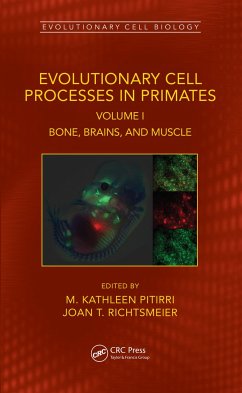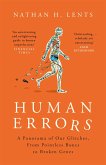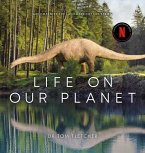Evolutionary Cell Processes in Primates
Bone, Brains, and Muscle, Volume I
Herausgeber: Pitirri, M Kathleen; Richtsmeier, Joan T
Evolutionary Cell Processes in Primates
Bone, Brains, and Muscle, Volume I
Herausgeber: Pitirri, M Kathleen; Richtsmeier, Joan T
- Gebundenes Buch
- Merkliste
- Auf die Merkliste
- Bewerten Bewerten
- Teilen
- Produkt teilen
- Produkterinnerung
- Produkterinnerung
This volume demonstrates the role of cellular mechanisms producing traits defining primates such as encephalization and various sensory systems. We highlight how genetic analysis, tissue and cell visualization, and merging Evo-Devo with cell biology combine to answer questions central to understanding human and primate evolution.
Andere Kunden interessierten sich auch für
![Evolutionary Cell Processes in Primates Evolutionary Cell Processes in Primates]() Evolutionary Cell Processes in Primates134,99 €
Evolutionary Cell Processes in Primates134,99 €![The Rise and Reign of the Mammals The Rise and Reign of the Mammals]() Steve BrusatteThe Rise and Reign of the Mammals9,99 €
Steve BrusatteThe Rise and Reign of the Mammals9,99 €![Regenerative Nephrology Regenerative Nephrology]() Regenerative Nephrology160,99 €
Regenerative Nephrology160,99 €![We Are All Apes We Are All Apes]() Aron RaWe Are All Apes12,99 €
Aron RaWe Are All Apes12,99 €![Morphogenesis and Evolution Morphogenesis and Evolution]() Keith Stewart ThomsonMorphogenesis and Evolution52,99 €
Keith Stewart ThomsonMorphogenesis and Evolution52,99 €![Human Errors Human Errors]() Nathan H. LentsHuman Errors8,99 €
Nathan H. LentsHuman Errors8,99 €![Life on Our Planet Life on Our Planet]() Tom FletcherLife on Our Planet30,99 €
Tom FletcherLife on Our Planet30,99 €-
-
This volume demonstrates the role of cellular mechanisms producing traits defining primates such as encephalization and various sensory systems. We highlight how genetic analysis, tissue and cell visualization, and merging Evo-Devo with cell biology combine to answer questions central to understanding human and primate evolution.
Produktdetails
- Produktdetails
- Verlag: CRC Press
- Seitenzahl: 270
- Erscheinungstermin: 29. September 2021
- Englisch
- Abmessung: 234mm x 156mm x 16mm
- Gewicht: 558g
- ISBN-13: 9780367437688
- ISBN-10: 0367437686
- Artikelnr.: 62220213
- Herstellerkennzeichnung
- Libri GmbH
- Europaallee 1
- 36244 Bad Hersfeld
- gpsr@libri.de
- Verlag: CRC Press
- Seitenzahl: 270
- Erscheinungstermin: 29. September 2021
- Englisch
- Abmessung: 234mm x 156mm x 16mm
- Gewicht: 558g
- ISBN-13: 9780367437688
- ISBN-10: 0367437686
- Artikelnr.: 62220213
- Herstellerkennzeichnung
- Libri GmbH
- Europaallee 1
- 36244 Bad Hersfeld
- gpsr@libri.de
M. Kathleen Pitirri, PhD is a Postdoctoral Scholar in the Department of Anthropology at Pennsylvania State University. She received her PhD from the University of Toronto in 2019 where she studied primate evolution, focusing specifically on the taxonomic, ontogenetic, and functional basis of mandibular shape variation in living and fossil primates. During her PhD research, Dr. Pitirri developed a novel methodology for studying shape variation of mandibular fragments that are part of the primate fossil record. She found a strong relationship between the shape of the mandibular corpus and molar crypt formation in great apes, suggesting that mandibular shape is linked to an extended period of development in great apes, representing an important evolutionary shift in primates. Upon joining the Richtsmeier Lab, Dr. Pitirri began using mouse models to study the cellular mechanisms involved in transferring information from the genotype to the phenotype. The changes observed in mouse models can be used to interpret the cellular basis for changes observed in skull shape in primates because mechanisms that build the craniofacial skeleton during development also drive variation in disease and evolution. Dr. Pitirri is particularly interested in the evolutionary consequences of change in developmental processes driving the patterning of cellular activities involved in embryogenesis of skull bones, the role of the chondrocranium in skull development, and the genetic pathways regulating the relationship between tooth and bone formation during embryonic development. Joan Richtsmeier is Distinguished Professor of Anthropology at the Pennsylvania State University. She received her PhD from Northwestern University in 1985 and joined the faculty of the Department of Cell Biology and Anatomy, Johns Hopkins University School of Medicine in 1986. There, she focused on establishing new quantitative methods for studying change in biological shape through time, especially in primates, with Professor Subhash Lele. In 1999 she became the 55th woman to achieve the rank of Professor at Johns Hopkins University School of Medicine since the school opened in 1893. In 2000, Dr. Richtsmeier moved her lab to the Pennsylvania State University. There, her focus turned to joining developmental biology with evolutionary biology, and with collaborators and students, she has worked to integrate the study of mouse models carrying known genetic variants with understanding the biological basis of patterns of evolutionary change. She is particularly interested in early formation of the chondrocranium and how and why cells decide to become osteoblasts and make bone. Dr. Richtsmeier was elected Fellow of the American Association of Anatomists (AAA) in 2018, received the Henry Gray Scientific Achievement Award of the AAA in 2019, and the David Bixler Excellence in Craniofacial Research Award of the Society for Craniofacial Genetics and Developmental Biology in 2019. She was elected Fellow of the AAAS (Section on Biological Sciences) in 2020. Her work is supported by grants from the National Science Foundation, the National Institutes of Health, and the Wellcome Trust.
Volume 1 Evolutionary Cell Processes in Primates: bone, brains, and muscle
Chapter 1 Introduction: Evolutionary cell biology in anthropological
research
Joan T. Richtsmeier and M. Kathleen Pitirri
Chapter 2 The role of bone and cartilage cells in the evolution of
bipedalism
Cambell Rolian
Chapter 3 Cellular processes in limb development and primate evolution
Philip L. Reno, Kelsey M. Kjosness, and Allison L. Machnicki
Chapter 4 A muscular perspective on human evolution: Locomotor insights
from analyses of primate muscle architecture and fiber type
Andrew S. Deane, Jason M. Organ, and Magdalena N. Muchlinski
Chapter 5 Evolution of the encephalized human brain: How did we become
exceptional?
Kevin Alloway and Kevin Flaherty
Chapter 6 Primate Cognition: cellular processes and the developmental
mechanisms in brain expansion
Maria Carolina Marchetto and Katerina Semendeferi
Chapter 7 The role of primate embryogenesis in encephalization and
neocortical expansion
Andrew Halley
Chapter 8 How gene expression can induce correlated changes in brain and
skull systems
Neus Martínez-Abadías, Rubèn Gonzàlez, Roger Mateu, Jaume Sastre, Alexandre
Robert-Moreno, Jim Swoger, Susan M. Motch Perrine, Kazuhiko Kawasaki, Joan
Richtsmeier, and James Sharpe
Chapter 9 Cellular dynamics and the developmental basis for craniofacial
variation in evolution and disease
Nathan M. Young, Ralph S. Marcucio, Benedikt Hallgrímsson, Heather A.
Richbourg, and Rebecca M. Green
Chapter 1 Introduction: Evolutionary cell biology in anthropological
research
Joan T. Richtsmeier and M. Kathleen Pitirri
Chapter 2 The role of bone and cartilage cells in the evolution of
bipedalism
Cambell Rolian
Chapter 3 Cellular processes in limb development and primate evolution
Philip L. Reno, Kelsey M. Kjosness, and Allison L. Machnicki
Chapter 4 A muscular perspective on human evolution: Locomotor insights
from analyses of primate muscle architecture and fiber type
Andrew S. Deane, Jason M. Organ, and Magdalena N. Muchlinski
Chapter 5 Evolution of the encephalized human brain: How did we become
exceptional?
Kevin Alloway and Kevin Flaherty
Chapter 6 Primate Cognition: cellular processes and the developmental
mechanisms in brain expansion
Maria Carolina Marchetto and Katerina Semendeferi
Chapter 7 The role of primate embryogenesis in encephalization and
neocortical expansion
Andrew Halley
Chapter 8 How gene expression can induce correlated changes in brain and
skull systems
Neus Martínez-Abadías, Rubèn Gonzàlez, Roger Mateu, Jaume Sastre, Alexandre
Robert-Moreno, Jim Swoger, Susan M. Motch Perrine, Kazuhiko Kawasaki, Joan
Richtsmeier, and James Sharpe
Chapter 9 Cellular dynamics and the developmental basis for craniofacial
variation in evolution and disease
Nathan M. Young, Ralph S. Marcucio, Benedikt Hallgrímsson, Heather A.
Richbourg, and Rebecca M. Green
Volume 1 Evolutionary Cell Processes in Primates: bone, brains, and muscle
Chapter 1 Introduction: Evolutionary cell biology in anthropological
research
Joan T. Richtsmeier and M. Kathleen Pitirri
Chapter 2 The role of bone and cartilage cells in the evolution of
bipedalism
Cambell Rolian
Chapter 3 Cellular processes in limb development and primate evolution
Philip L. Reno, Kelsey M. Kjosness, and Allison L. Machnicki
Chapter 4 A muscular perspective on human evolution: Locomotor insights
from analyses of primate muscle architecture and fiber type
Andrew S. Deane, Jason M. Organ, and Magdalena N. Muchlinski
Chapter 5 Evolution of the encephalized human brain: How did we become
exceptional?
Kevin Alloway and Kevin Flaherty
Chapter 6 Primate Cognition: cellular processes and the developmental
mechanisms in brain expansion
Maria Carolina Marchetto and Katerina Semendeferi
Chapter 7 The role of primate embryogenesis in encephalization and
neocortical expansion
Andrew Halley
Chapter 8 How gene expression can induce correlated changes in brain and
skull systems
Neus Martínez-Abadías, Rubèn Gonzàlez, Roger Mateu, Jaume Sastre, Alexandre
Robert-Moreno, Jim Swoger, Susan M. Motch Perrine, Kazuhiko Kawasaki, Joan
Richtsmeier, and James Sharpe
Chapter 9 Cellular dynamics and the developmental basis for craniofacial
variation in evolution and disease
Nathan M. Young, Ralph S. Marcucio, Benedikt Hallgrímsson, Heather A.
Richbourg, and Rebecca M. Green
Chapter 1 Introduction: Evolutionary cell biology in anthropological
research
Joan T. Richtsmeier and M. Kathleen Pitirri
Chapter 2 The role of bone and cartilage cells in the evolution of
bipedalism
Cambell Rolian
Chapter 3 Cellular processes in limb development and primate evolution
Philip L. Reno, Kelsey M. Kjosness, and Allison L. Machnicki
Chapter 4 A muscular perspective on human evolution: Locomotor insights
from analyses of primate muscle architecture and fiber type
Andrew S. Deane, Jason M. Organ, and Magdalena N. Muchlinski
Chapter 5 Evolution of the encephalized human brain: How did we become
exceptional?
Kevin Alloway and Kevin Flaherty
Chapter 6 Primate Cognition: cellular processes and the developmental
mechanisms in brain expansion
Maria Carolina Marchetto and Katerina Semendeferi
Chapter 7 The role of primate embryogenesis in encephalization and
neocortical expansion
Andrew Halley
Chapter 8 How gene expression can induce correlated changes in brain and
skull systems
Neus Martínez-Abadías, Rubèn Gonzàlez, Roger Mateu, Jaume Sastre, Alexandre
Robert-Moreno, Jim Swoger, Susan M. Motch Perrine, Kazuhiko Kawasaki, Joan
Richtsmeier, and James Sharpe
Chapter 9 Cellular dynamics and the developmental basis for craniofacial
variation in evolution and disease
Nathan M. Young, Ralph S. Marcucio, Benedikt Hallgrímsson, Heather A.
Richbourg, and Rebecca M. Green








